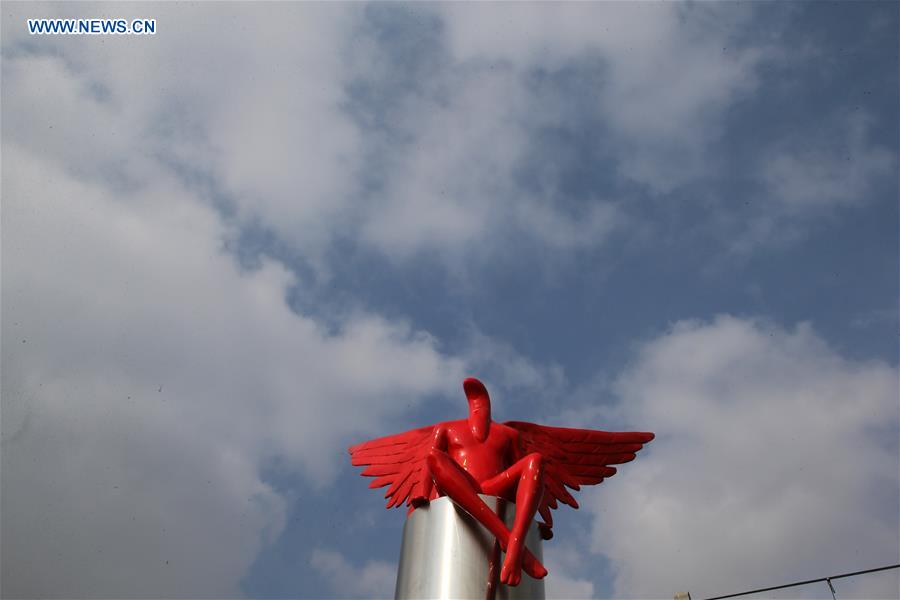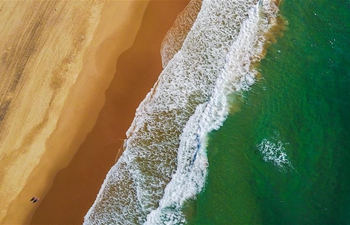
Photo taken on Jan. 9, 2018 shows the sculpture "Phylax" (Guardian in Greek) near the marina of the municipality of Paleo Faliro, Greece. On Dec. 5, 2017 the sculpture "Phylax" (Guardian in Greek) by well-known and internationally-established sculptor and painter Kostis Georgiou was placed on the beachfront avenue of the Athens Riviera, near the marina of the municipality of Paleo Faliro. (Xinhua/Marios Lolos)
by Maria Spiliopoulou, Valentini Anagnostopoulou
ATHENS, Jan. 13 (Xinhua) -- On Dec. 5, 2017 the sculpture "Phylax" (Guardian in Greek) by well-known and internationally-established sculptor and painter Kostis Georgiou was placed on the beachfront avenue of the Athens Riviera, near the marina of the municipality of Paleo Faliro.
The bright-red metal installation depicting a male figure with wings, was a donation of a Greek shipping family and was warmly welcomed by local authorities as another step in efforts to bring art closer to people who rarely frequent museums and galleries.
By the year end Georgiou, Mayor of Paleo Faliro Dionysis Hatzidakis, prominent academics and artists found themselves defending "Phylax" against a small minority of locals who rejected the work as "satanistic."
In social media users initially commented about a bad joke when an ultra-conservative Greek Orthodox priest who demands its removal led a few dozen parishioners to the site and sprinkled "holy water" on "Phylax" to "exorcise the soldier of Satan."
When unidentified vandals sprayed white paint on the sculpture and cut electricity wires to keep it in the dark at night, reopened a serious discussion about the lack of art education and the battle against prejudice and minorities of religious fanatics.
"How a viewer approaches a work of art depends on the codes each of us has in life; our knowledge of art," the mayor said in an e-mailed press statement.
The particular sculptor bears no relation to the "guardian angel" of Christian tradition, he stressed.
In ancient Greek mythology and art, there were several such "guardians", like Talos, the mythical guardian of Crete island, who was mentioned by Plato, or the Sphinxes placed to protect sites from evil, the mayor noted.
Sculptures made by the artist using a similar technique and use of color have also been placed in public spaces of other southern suburbs, as well as Mykonos last summer, with no negative reactions.
Georgiou studied at the University of fine arts in Athens and the Royal College of Fine Arts in London. He taught painting and scenography at a major school of cinema in Athens.
His works can be found in museums, galleries, private collections and public areas in Greece and abroad, from France to China.
He has had more than 130 solo exhibitions in major galleries and museums throughout the world and taken part in more than 300 group exhibitions.
"I was surprised...I could not believe that there was such a distorted reading of a sculpture... This is the first time ever I have faced such a reaction," Georgiou told Xinhua.
"The work was interpreted in a wrong manner. It was interpreted as an angel who due to the color was perceived as satanistic, something that is entirely opposite to my beliefs," the artist stressed.
He explained that he has never used symbolism, because he wants to allow viewers to take their own journey without guiding them to one direction.
"This is it. There is nothing more. There is no symbolism... I did not intend to symbolize something in particular. I just wanted to add this bright red strike of color to this beautiful environment," he said.
Georgiou had never faced a storm triggered by his work before Phylax, but in Greece renowned artists in the past have been attacked for their "offensive" theatrical plays, movies or books by similar ultra-conservative minor groups.
"To be honest I understand them a little, because you know, art education in Greece is almost nonexistent," the artist said.
Only through education and open mind societies can beat prejudice, absurdity, dark-ages rationale and behavior, Georgiou underlined.
The Greek artist praised Chinese people for embracing novelties and different proposals with an open mind.
He has visited China several times, has had sculptures installed in public spaces and presented his work in solo and group exhibitions in many museums and galleries, such as the Suzhou museum, the Shaanxi Art Museum and the Feizi Gallery in Shanghai.
The "Dialogue with Emperor Qin- EU and China sculpture show" exhibition which included works of European and Chinese artists inspired by Xi'an's terracotta warriors, was hosted in many Chinese museums between 2011-2013 and recently in Antwerp, the Netherlands.
Yorgos Kartalos, owner of gallery "Agathi-kARTalos" (Thorn in Greek) which during a course of over four decades has hosted more than 300 exhibitions of the greatest contemporary Greek painters and sculptors, is launching an exhibition of Georgiou's works next week.
"The work is worthily at the place where it has been installed... It undoubtedly helps raise the aesthetics. In general in current times it is an oasis, I would say," Kartalos told Xinhua asked to comment on Phylax.
"I am hearing about a divided public opinion and society. Society has embraced it, society understands a lot and I believe receives a lot from art which above all has no boundaries," he added.
"Society is not divided in this case. There is a minority of people who have a different point of view, wrong of course, and I hope that one day they will realize that Art helps us enjoy life, think, make our heart beat and progress," he said.















